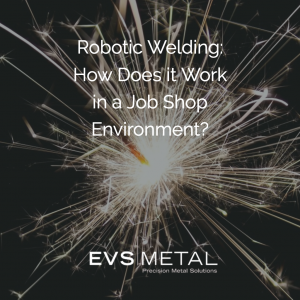Article Revised August 26th, 2022
 Robotic welding may not be new, but it continues to evolve rapidly enough that one would be hard-pressed to think of it as anything other than modern technology. Because of the complexity of the process, we decided that a series of blogs was in order to best showcase robot welding as an end-to-end operation. Until now, we’ve mainly covered the basics, but today, we’ll be getting a little more into the weeds by explaining how this type of welding works in a precision sheet metal fabrication job shop setting.
Robotic welding may not be new, but it continues to evolve rapidly enough that one would be hard-pressed to think of it as anything other than modern technology. Because of the complexity of the process, we decided that a series of blogs was in order to best showcase robot welding as an end-to-end operation. Until now, we’ve mainly covered the basics, but today, we’ll be getting a little more into the weeds by explaining how this type of welding works in a precision sheet metal fabrication job shop setting.
How does robotic welding work?
Generally, robot welding occurs within a robotic welding cell and features two primary components: a positioner with the appropriate handling capacity and the welding robot itself. The positioner can be either single station or dual/twin station in configuration. The choice of one over the other comes down to the type of item being assembled. Large assemblies that require longer weld cycles are often better suited to single station setups; dual/twin stations can be a better solution for high-mix, low-volume conditions.
Looking for precision sheet metal fabrication and machining services?

What are the primary features of a robotic welding cell?
There are a number of different features that work together to make a functioning welding cell. Besides the positioner and welding robot, some of the most important include:
- Controller: Supplies power to the robot and stores information such as programs that tell the robot and positioners how, when, and where to move.
- Torch: Joins materials together in the weld, utilizing inert gasses to protect the arc weld while in process.
- Wire Feeder and Cleaner: Moves the filler wire at the speed programmed into the controller while the wire cleaner removes welding spatter from the torch, helping to keep the equipment in good working condition.
- Welding Power Supply: Powers the welding torch to produce an arc — can vary greatly in size and performance, depending on the job’s requirements.
A quality robot welding cell will also include important safety features such as shields to protect operators from arc flash. An arc flash is a type of electrical discharge that can exceed 35,000 degrees Fahrenheit. It can travel through the air between conductors, and if workers are exposed to the flash, the resulting explosion or potential fires may harm both people and equipmentRobotic welding requires balancing multiple variables, but due to its automated nature, it can be easy to miss just how complex it can be. From welding program selection to the assembled end product, there are many factors that need to be considered in order to complete a job in a way that ensures that joined areas are completely stable and uncompromised from start to finish.
Robotic welding requires balancing multiple variables, but because of its automated nature, it’s easy to miss just how complex it can be. From welding program selection to the assembled end product, there are many factors that need to be considered in order to complete a job in a way that ensures that joined areas are completely stable and uncompromised from start to finish.
Interested in learning more about our robotic bending capabilities? Get an online quote, or call 1-888-9EVSMet.





